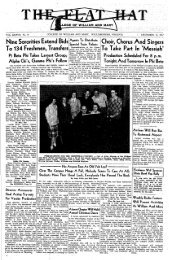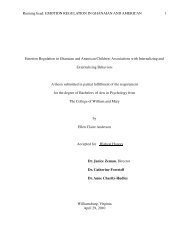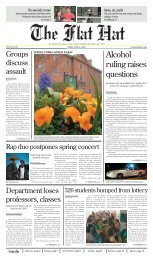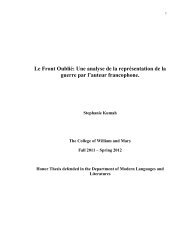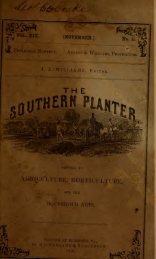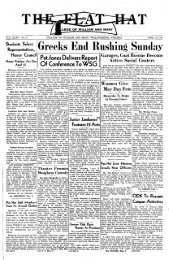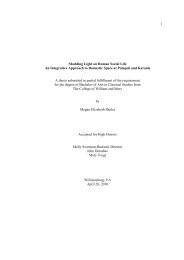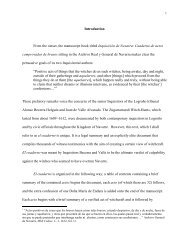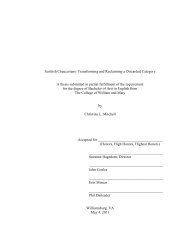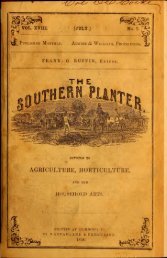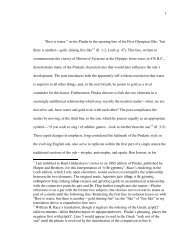Southern planter - The W&M Digital Archive
Southern planter - The W&M Digital Archive
Southern planter - The W&M Digital Archive
You also want an ePaper? Increase the reach of your titles
YUMPU automatically turns print PDFs into web optimized ePapers that Google loves.
1908.]<br />
ROTATION OF CROPS.<br />
Editor /<strong>Southern</strong> Planter:<br />
<strong>The</strong>re is no subject connected with farming more important<br />
than that of crop rotation, and I wish to commend<br />
the rotation suggested by Mr. Hicks in the last number<br />
of the Planter. I think, however, he is wrong when he ex<br />
presses the opinion that rye will not pay as a cover crop<br />
after corn. It is true that rye will add no nitrogen to (the<br />
soil and should be turned under before it has made much<br />
growth or it will remove too much moisture. It will do<br />
nothing but conserve fertility; it will aid in holding what<br />
the soil gains during Mr. Hick's excellent rotation. I<br />
know that the Planter has pointed out time and time<br />
again the harmfulness of leaving a held bare during the<br />
winter, but it is slow work driving a new idea home. You<br />
may persuade a farmer to adopt a sensible rotation as<br />
long as he gets something off the land but he can't appre-<br />
ciate a loss unless it is visible "to the eye. In raising a<br />
heavy weight it is good to make a long pull, a strong pull<br />
and a pull all together but it is quite as important to hold<br />
what you have gained. Rye is the hold-fast and by all<br />
means should be included in Mr. Hick's rotation. 0n8<br />
question—will the double^action harrow, without plowing,<br />
suitably prepare the land for cow peas or soja beans?<br />
Bedford Co., Va. M. A. CROCKETT.<br />
Either the double-action harrow or a disc harrow will<br />
effectually prepare the stubble land for a crop of cow peas<br />
or soja beans. It should be run lengthwise and across the<br />
field.—^Ed.<br />
Editor <strong>Southern</strong> Planter:<br />
LAND IMPROVEMENT.<br />
After reading the article of Prof Massey and your editorial<br />
note thereon in the last issue, I feel impelled to an<br />
expression on this subject, although greatly in fear 'that 1<br />
shall only illustrate the proverb that "fools rush in where<br />
angels fear to tread." As I understand Prof. Massey, he<br />
claims that even where every pound of grain and roughage<br />
grown on the farm is consumed by live stock, and 'the<br />
manure carefully saved and returned to the soil, there<br />
must be a gradual loss of phosphoric acid and potash, the<br />
same being carried off by milk or meat, eggs, butter or<br />
whatever products leave the place. In other words every<br />
farmer must eventually become a buyer of both phospho-<br />
ric acid and potash or reconcile himself to leaving a poorer<br />
farm than he inherited from his predecessors. This is a<br />
question which has often occurred to me and one that is<br />
hard to answer. <strong>The</strong>oretically, Prof Massey is right and<br />
he can prove his position by figures; for unless there is<br />
an inexhaustible supply of the necessary mineral elements<br />
in the soil it must eventually become depleted.<br />
<strong>The</strong> question which confronts us resolves itself into<br />
this: Is the supply of phosphoric acid and potash inex-<br />
haustible? and capable of treatment to make it perennially<br />
available? Or is It not? And I think it is about the most<br />
important one that confronts humanity.<br />
In view of our present experience it is possible to throw<br />
a little light on this subject, from both points of view.<br />
In the first place, all will admit that it is possible to take<br />
any piece of land rich in mineral elements, and to grow<br />
corn or wheat on it year after year and by so doing ex-<br />
THE SOUTHERN PLANTER.<br />
haust the available phosphoric acid and potasii, as indi-<br />
cated by the gradual decrease in the yield, until it gets<br />
to a point beyond which it does not pay to cultivate; but<br />
the experiments at Rothamstead, and in fact the observa-<br />
tion of every intelligent farmer goes to show that after a<br />
while land so treated gets into a state where it will not de-<br />
teriorate any further; in other words, where the annual loss<br />
of mineral constituents is so small Uiat .me natural process<br />
of soil weathering, brought about by cutUvauou, win balance<br />
it, and the land will go on producing its minimum<br />
crop indefinitely, the only variation being due to climatic<br />
conditions favorable or otherwise to the crop. That tnis<br />
is the case on 'the vast majority or laud will be pretty gen-<br />
erally conceded, and the fact that tne amount of grain<br />
produced will be so small as to make its cultivation un-<br />
profitable does not bear upon the argument that here is<br />
land that is perennially fertile. <strong>The</strong>re is anotuer point<br />
that I desire to establish in order to perfect my premises,<br />
and that is that all land will not deteriorate to the same<br />
point; some will go as low as a few bushels of corn or<br />
wheat per acre, some will stop at two bushels of the<br />
former and 4 or 5 bushels of the latter per acre, the experiments<br />
at Rothamstead seem to point to 12 bushels of<br />
wheat as the minimum under tbeir conditions of soil and<br />
climate and the question has never, so far as I know, been<br />
decided as to 'the determining factor, whether it was lack<br />
of phosphoric acid, or nitrogen.<br />
If we admit, then, that all lands have a state of minimum<br />
production beyond which point they will not go under<br />
conditions of proper cultivation, and that lands differ in<br />
their productive capacity after reaching this point, the<br />
important thing to find out is first the cause of this dif-<br />
ference and second the remedy to apply in order to bring<br />
the poorer lands up to the standard of the best lands.<br />
Here is a problem quite as abstruse as any that is engag-<br />
ing the attention of the scientists at our Experiment Sta-<br />
tions, and one which, if solved on a commercial basis<br />
within reach of the average agriculturist, would be of as<br />
great benefit to the American farmer as any that can<br />
engage the attention of the philantropist.<br />
Soil analysis seems to show that 'the supply of phos-<br />
phoric 'acid and potash in the average land is far in ex-<br />
cess, of the needs of any crop, no matter how luxuriant,<br />
but that something is lacking to make it available, and<br />
now, that we have hastily reviewed the known, let ua<br />
turn to the field of conjecture.<br />
My own experience on a run-down farm would seem to<br />
indicate that nitrogen was the lacking element, for the<br />
growth of legumes alone, without manure or fertilizer,<br />
will make an improvement in most of the lands that have<br />
come under my observation in Virginia. If this is the<br />
case, then by alternating corn and peas, or common<br />
clover and wheat, on the same land that produces five<br />
bushels of wheat or two barrels of corn as its minimum<br />
crop, we should increase that yield a little, and I believe<br />
this will generally be the case even without the addition<br />
of one pound of commercial fertilizer or manure of any<br />
sort; a steady rotation which follows every cereal crop<br />
with a legume must eventually carry the land up to an-<br />
other and increased point of productivity. We will say<br />
for argumentative purposes four barrels of corn and ten



